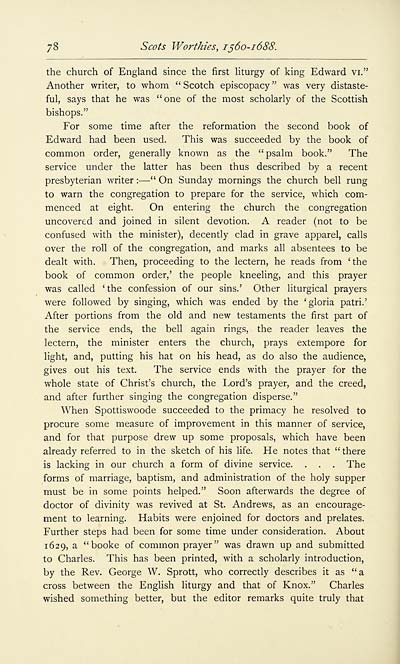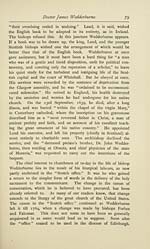Scots worthies, 1560-1688
(98) Page 78
Download files
Complete book:
Individual page:
Thumbnail gallery: Grid view | List view

78 Scots Worthies, 1 560-1688.
the church of England since the first liturgy of king Edward VI."
Another writer, to whom " Scotch episcopacy " was very distaste-
ful, says that he was "one of the most scholarly of the Scottish
bishops."
For some time after the reformation the second book of
Edward had been used. This was succeeded by the book of
common order, generally known as the "psalm book." The
service under the latter has been thus described by a recent
presbyterian writer : — ■" On Sunday mornings the church bell rung
to warn the congregation to prepare for the service, which com-
menced at eight. On entering the church the congregation
uncovered and joined in silent devotion. A reader (not to be
confused with the minister), decently clad in grave apparel, calls
over the roll of the congregation, and marks all absentees to be
dealt with. Then, proceeding to the lectern, he reads from 'the
book of common order,' the people kneeling, and this prayer
was called ' the confession of our sins.' Other liturgical prayers
were followed by singing, which was ended by the 'gloria patri.'
After portions from the old and new testaments the first part of
the service ends, the bell again rings, the reader leaves the
lectern, the minister enters the church, prays extempore for
light, and, putting his hat on his head, as do also the audience,
gives out his text. The service ends with the prayer for the
whole state of Christ's church, the Lord's prayer, and the creed,
and after further singing the congregation disperse."
When Spottiswoode succeeded to the primacy he resolved to
procure some measure of improvement in this manner of service,
and for that purpose drew up some proposals, which have been
already referred to in the sketch of his life. He notes that " there
is lacking in our church a form of divine service. . . . The
forms of marriage, baptism, and administration of the holy supper
must be in some points helped." Soon afterwards the degree of
doctor of divinity was revived at St. Andrews, as an encourage-
ment to learning. Habits were enjoined for doctors and prelates.
Further steps had been for some time under consideration. About
1629, a "booke of common prayer" was drawn up and submitted
to Charles. This has been printed, with a scholarly introduction,
by the Rev. George W. Sprott, who correctly describes it as " a
cross between the English liturgy and that of Knox." Charles
wished something better, but the editor remarks quite truly that
the church of England since the first liturgy of king Edward VI."
Another writer, to whom " Scotch episcopacy " was very distaste-
ful, says that he was "one of the most scholarly of the Scottish
bishops."
For some time after the reformation the second book of
Edward had been used. This was succeeded by the book of
common order, generally known as the "psalm book." The
service under the latter has been thus described by a recent
presbyterian writer : — ■" On Sunday mornings the church bell rung
to warn the congregation to prepare for the service, which com-
menced at eight. On entering the church the congregation
uncovered and joined in silent devotion. A reader (not to be
confused with the minister), decently clad in grave apparel, calls
over the roll of the congregation, and marks all absentees to be
dealt with. Then, proceeding to the lectern, he reads from 'the
book of common order,' the people kneeling, and this prayer
was called ' the confession of our sins.' Other liturgical prayers
were followed by singing, which was ended by the 'gloria patri.'
After portions from the old and new testaments the first part of
the service ends, the bell again rings, the reader leaves the
lectern, the minister enters the church, prays extempore for
light, and, putting his hat on his head, as do also the audience,
gives out his text. The service ends with the prayer for the
whole state of Christ's church, the Lord's prayer, and the creed,
and after further singing the congregation disperse."
When Spottiswoode succeeded to the primacy he resolved to
procure some measure of improvement in this manner of service,
and for that purpose drew up some proposals, which have been
already referred to in the sketch of his life. He notes that " there
is lacking in our church a form of divine service. . . . The
forms of marriage, baptism, and administration of the holy supper
must be in some points helped." Soon afterwards the degree of
doctor of divinity was revived at St. Andrews, as an encourage-
ment to learning. Habits were enjoined for doctors and prelates.
Further steps had been for some time under consideration. About
1629, a "booke of common prayer" was drawn up and submitted
to Charles. This has been printed, with a scholarly introduction,
by the Rev. George W. Sprott, who correctly describes it as " a
cross between the English liturgy and that of Knox." Charles
wished something better, but the editor remarks quite truly that
Set display mode to:
![]() Universal Viewer |
Universal Viewer | ![]() Mirador |
Large image | Transcription
Mirador |
Large image | Transcription
Images and transcriptions on this page, including medium image downloads, may be used under the Creative Commons Attribution 4.0 International Licence unless otherwise stated. ![]()
| Histories of Scottish families > Scots worthies, 1560-1688 > (98) Page 78 |
|---|
| Permanent URL | https://digital.nls.uk/95152202 |
|---|
| Description | A selection of almost 400 printed items relating to the history of Scottish families, mostly dating from the 19th and early 20th centuries. Includes memoirs, genealogies and clan histories, with a few produced by emigrant families. The earliest family history goes back to AD 916. |
|---|

